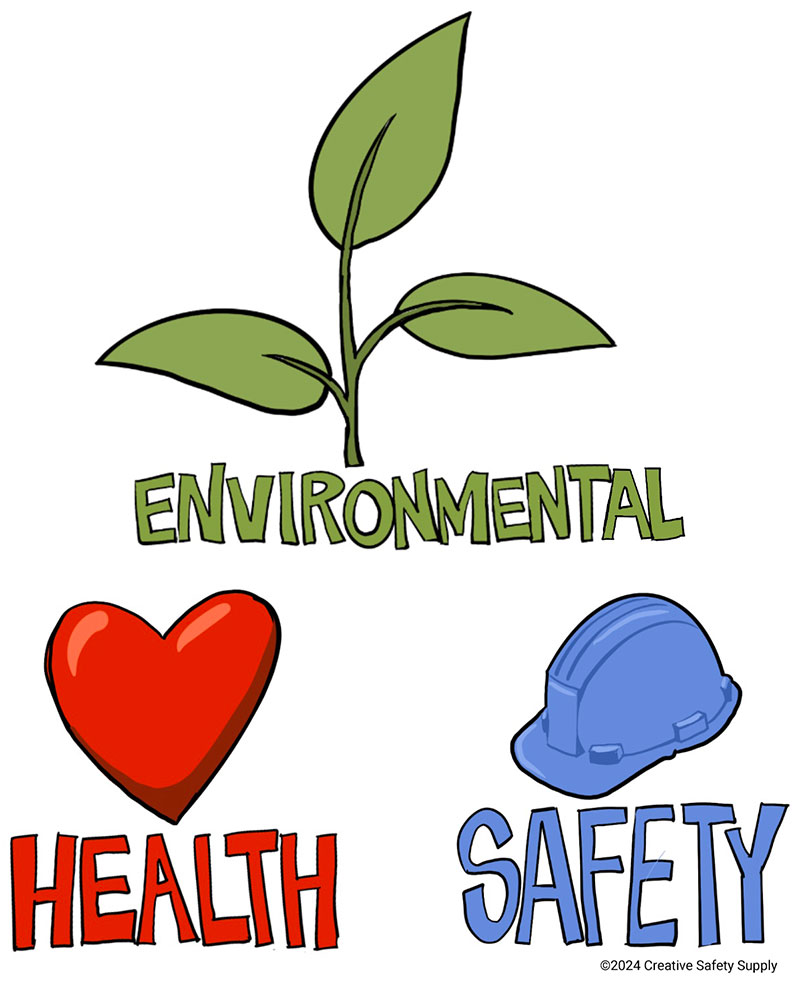
EHS stands for Environment, Health, and Safety. Companies in a variety of industries have adopted EHS programs that not only ensure employees are safe at work, but also ensure that the quality of the environment and the health of the local community are protected from any hazards or consequences of the company’s operations, such as an accidental spill of dangerous substances. Unlike OSHA, which is an authority that has the ability to enforce standards and fine businesses for violating these standards, EHS is more of a discipline that businesses practice for the betterment of the community and the planet. Depending on the program and the company’s priorities, the acronym may be in different renditions such as HSE or SHE. Quality control and assurance are often added, making the acronym QHSE or a variation of.

Environment
This category describes the company’s strategy to minimize its carbon footprint and how it aims to protect the environment. Topics include waste management, water and energy conservation, air emissions, and ensuring water quality. One of the biggest aspects to any business’s environmental program is hazardous material management and the prevention of contaminating waters that are near the business or contaminating the land which it occupies.
Health
This category ensures that the operations of the company don’t negatively impact the health and wellness of the local community. This addresses the availability and quality of water, traffic safety, the transport of hazardous materials, and the safety of infrastructure—for example, the collapse of the Hard Rock hotel construction in New Orleans in October 2019 killed three workers and compromised the safety of local residents, as the city has been unable to clear the partially-demolished wreckage. This health category also focuses on disease prevention. It establishes procedures for emergency preparedness and response to any accidental spills or release of hazardous substances, in order to ensure that the local community is protected quickly and efficiently.
Safety
The safety category mainly encompasses how the company addresses hazards that are either already present in the workplace or have the potential to become present. The EHS program should describe the company’s procedure for taking action to reduce or eliminate these hazards. This typically involves a communication program, extensive training, and providing/using personal protective equipment. Hazards include those that are physical, chemical, biological, or radiological.
Although EHS does adhere to regulations established by OSHA, many EHS programs go beyond required compliance. Companies that practice EHS typically do as much as they possibly can to protect their workers, community, and environment.
Additional EHS facts:
- EHS stands for Environment, Health, and Safety. It is a general term that refers to the laws, rules, regulations, professions, programs, and workplace efforts that aim to protect the health and safety of employees, the public, and the environment from hazards associated with the workplace. Source: https://www.vectorsolutions.com/resources/blogs/what-is-ehs-and-why-is-it-important/
- Environment, health and safety (EHS) is a multidisciplinary field that studies and implements the practical aspects of protecting the environment and maintaining health and safety at work. In simple terms, it is what organizations must do to make sure that their activities do not cause harm to anyone. Source: https://en.wikipedia.org/wiki/Environment,_health_and_safety
- EHS management refers to the implementation of procedures that focus on ensuring and improving the safety of workers and their surroundings, and it plays a significant role in achieving the overall environmental goals of the organization. Source: https://www.compliancequest.com/what-is-ehs-and-why-is-it-important/
- There were 2.61 million nonfatal workplace safety incidents and 5,190 fatal workplace safety incidents in 2021 in the United States. These incidents include slips, trips, falls; illnesses; and other nonfatal and fatal injuries. These numbers show the importance of EHS programs and practices to prevent or reduce the risk of harm to workers. Source: https://www.alertmedia.com/blog/workplace-safety-statistics/
- OSHA is the federal agency that enforces EHS regulations and standards in the United States. OSHA also provides guidance, training, and resources on various EHS topics, such as heat stress, ergonomics, chemical hazards, and emergency preparedness. Source: https://www.osha.gov/topics
Similar Questions
- What is PSM?
- What Safety Measures Prevent Accidents at Work?
- What is the NSC?
- Where should emergency eye wash stations and showers be located?


